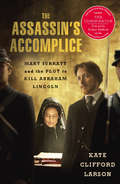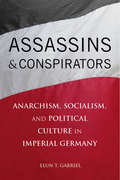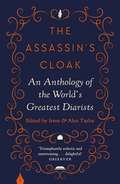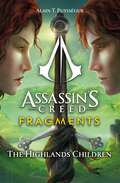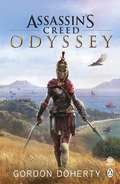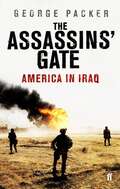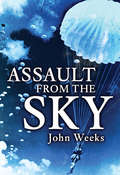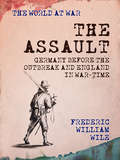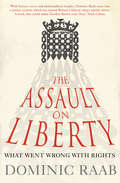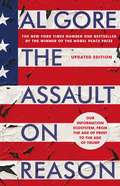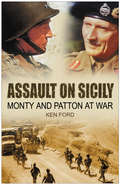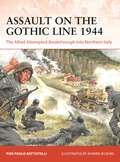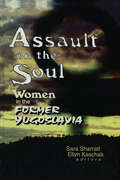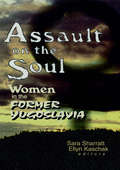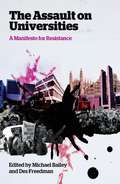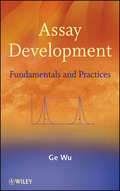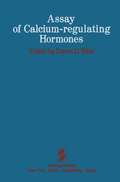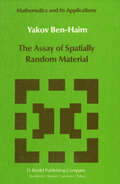- Table View
- List View
The Assassin's Accomplice: Mary Surratt and the Plot to Kill Abraham Lincoln
by Kate Clifford LarsonIn The Assassin's Accomplice, historian Kate Clifford Larson tells the gripping story of Mary Surratt, a little-known participant in the plot to kill Abraham Lincoln, and the first woman ever to be executed by the federal government of the United States. Surratt, a Confederate sympathizer, ran the boarding house in Washington where the conspirators-including her rebel son, John Surratt-met to plan the assassination. When a military tribunal convicted her for her crimes and sentenced her to death, five of the nine commissioners petitioned President Andrew Johnson to show mercy on Surratt because of her sex and age. Unmoved, Johnson refused-Surratt, he said, "kept the nest that hatched the egg." Set against the backdrop of the Civil War, The Assassin's Accomplice tells the intricate story of the Lincoln conspiracy through the eyes of its only female participant. Based on long-lost interviews, confessions, and court testimony, the text explores how Mary's actions defied nineteenth-century norms of femininity, piety, and motherhood, leaving her vulnerable to deadly punishment historically reserved for men. A riveting narrative account of sex, espionage, and murder cloaked in the enchantments of Southern womanhood, The Assassin's Accomplice offers a fresh perspective on America's most famous murder.
Assassins and Conspirators: Anarchism, Socialism, and Political Culture in Imperial Germany
by Elun GabrielOver the course of the German Empire the Social Democrats went from being a vilified and persecuted minority to becoming the largest party in the Reichstag, enjoying broad-based support. But this was not always the case. In the 1870s, government mouthpieces branded Social Democracy the "party of assassins and conspirators" and sought to excite popular fury against it. Over time, Social Democrats managed to refashion their public image in large part by contrasting themselves to anarchists, who came to represent a politics that went far beyond the boundaries of acceptable behavior. Social Democrats emphasized their overall commitment to peaceful change through parliamentary participation and a willingness to engage their political rivals. They condemned anarchist behavior—terrorism and other political violence specifically—and distanced themselves from the alleged anarchist personal characteristics of rashness, emotionalism, cowardice, and secrecy. Repeated public debate about the appropriate place of Socialism in German society, and its relationship to anarchist terrorism, helped Socialists and others, such as liberals, political Catholics, and national minorities, cement the principles of legal equality and a vigorous public sphere in German political culture.Using a diverse array of primary sources from newspapers and political pamphlets to Reichstag speeches to police reports on anarchist and socialist activity, this book sets the history of Social Democracy within the context of public political debate about democracy, the rule of law, and the appropriate use of state power. Gabriel also places the history of German anarchism in the larger contexts of German history and the history of European socialism, where its importance has often been understated because of the movement's small size and failure to create a long-term mass movement.
The Assassin's Cloak: An Anthology of the World's Greatest Diarists
by Irene and Alan Taylor'A diary is an assassin's cloak which we wear when we stab a comrade in the back with a pen', wrote William Soutar in 1934. But a diary is also a place for recording everyday thoughts and special occasions, private fears and hopeful dreams. The Assassin's Cloak gathers together some of the most entertaining and inspiring entries for each day of the year, as writers ranging from Queen Victoria to Andy Warhol, Samuel Pepys to Adrian Mole, pen their musings on the historic and the mundane. Spanning centuries and international in scope, this peerless anthology pays tribute to a genre that is at once the most intimate and public of all literary forms. This new updated edition is published to mark the twentieth anniversary of the book's original publication.
Assassin's Creed - Escape Room Puzzle Book: Explore Assassin's Creed in an escape-room adventure
by James Hamer-Morton UbisoftThe Assassin's Creed Escape Room Puzzle Book is an exciting journey through history in which you must solve a series of puzzles and mysteries to save humanity. You are Joey, a museum worker who comes across a mysterious blade that sets in motion a chain of events that completely upends your life. Drawn into the world of the Assassins, you must tour through time and space – from 5th century BCE Greece to the catacombs of medieval Venice – in order to foil a malevolent Isu plot.Featuring characters and locations familiar to fans of the Assassin's Creed franchise and written by an experienced real-life escape-room creator, this immersive escape-room experience is both visually exciting and a difficult puzzle quest.Can you solve the conundrums and reveal the Isu plan in time to save the world?
Assassin’s Creed Odyssey: The official novel of the highly anticipated new game
by Gordon DohertyGet ready for Odyssey: journey deeper in the world of Assassin's Creed in the official novel of the highly anticipated new game, coming October 2018.Greece, 5th century BCE. Kassandra is a mercenary of Spartan blood, sentenced to death by her family, cast out into exile. Now she will embark on an epic journey to become a legendary hero - and uncover the truth about her mysterious lineage.The Assassin's Creed novels have sold more than 1 million copies around the world, gaining almost 30,000 4 and 5 star reviews. See what readers are already saying about the series that lets you dive deeper into the world behind the highly acclaimed video game series:'A brilliant read' *****'I love this book' *****'Original and unique' *****'A brilliant accompaniment to the games' *****New Feature Information0
The Assassins' Gate (PDF): America in Iraq
by George PackerThe Assassins' Gate recounts how the United States set about changing the history of the Middle East and became ensnared in a guerrilla war in Iraq. The consequences of that policy are shown in the author's vivid reporting on the ground in Iraq, where he made several tours on assignment for The New Yorker. We see up close the struggles of individual American soldiers and civilians and Iraqis from all backgrounds. Here is the full range of ideas and emotions stirred up by America's most controversial foreign-policy venture since Vietnam.
Assault From the Sky: The History of Airborne Warfare 1939–1980s (Osprey Digital Generals Ser.)
by John WeeksThe introduction of Airborne forces revolutionised military tactics and thinking throughout the twentieth century. In this exciting edition, ex-paratrooper John Weeks presents a history of the Airborne forces across the globe, studying the generals, the planners and parachutists, as well as the aircraft, gliders, weapons and helicopters, alongside a look at their background and their most famous actions, such as Crete, Arnhem, D-Day and the crossing the Rhine. Within each chapter Weeks presents a detailed analyses of the main airborne forces. Airborne raids caught popular imagination from early in the Second World War, when the Germans carried out daring and alarming raids. The assault is fast and dynamic, and most of all, unpredictable, which in the early 1940s led all participants of the war to develop airborne forces of their own.
Assault From the Sky: The History of Airborne Warfare 1939–1980s (Osprey Digital Ser.)
by John WeeksThe introduction of Airborne forces revolutionised military tactics and thinking throughout the twentieth century. In this exciting edition, ex-paratrooper John Weeks presents a history of the Airborne forces across the globe, studying the generals, the planners and parachutists, as well as the aircraft, gliders, weapons and helicopters, alongside a look at their background and their most famous actions, such as Crete, Arnhem, D-Day and the crossing the Rhine. Within each chapter Weeks presents a detailed analyses of the main airborne forces. Airborne raids caught popular imagination from early in the Second World War, when the Germans carried out daring and alarming raids. The assault is fast and dynamic, and most of all, unpredictable, which in the early 1940s led all participants of the war to develop airborne forces of their own.
The Assault Germany Before the Outbreak and England in War-Time: Germany Before The Outbreak And England In War-time; A Personal Narrative (The World At War)
by Frederic WileExcerpt: "During the war I have lived in Germany, England and the United States--a week of it in Berlin, three months at different periods in America, and the rest of the time in London. My observations of Germany have not been confined to the six and a half days the Prussian police permitted me to tarry in their midst, for my work in London has dealt almost exclusively with day-by-day examination of that weird production which will be known to history as the German war-time Press. I am quite sure the perspective of the life and times of the Kaiser's people in their "great hour" was clearer from the vantage-ground of a newspaper desk near the Thames embankment than it could possibly have been had it been my lot to view the Fatherland at war as an observer writing, under the hypnotic influence of mass-suggestion, of Germany from within."
The Assault on International Law
by Jens David OhlinInternational law presents a conceptual riddle. Why comply with it when there is no world government to enforce it? The United States has a long history of skepticism towards international law, but 9/11 ushered in a particularly virulent phase of American exceptionalism, as the US drifted away from international institutions and conventions. Although American politicians and their legal advisors are often the public face of this attack, the root of this movement is a coordinated and deliberate attack by law professors hostile to its philosophical foundations, including Eric Posner, Jack Goldsmith, Adrian Vermeule, and John Yoo. In a series of influential writings, they have claimed that since states are motivated primarily by self-interest, compliance with international law is nothing more than high-minded talk. These abstract arguments provide a foundation for dangerous legal conclusions: that international law is largely irrelevant to determining how and when terrorists can be captured or killed; that the US President alone should be directing the War on Terror without significant input from Congress or the judiciary; that US courts should not hear lawsuits alleging violations of international law; and that the US should block any international criminal court with jurisdiction over Americans. These polemical accounts have ultimately triggered America's pernicious withdrawal from international cooperation. In The Assault on International Law, Jens David Ohlin exposes the mistaken assumptions of these "New Realists," in particular their impoverished utilization of rational choice theory. In contrast, he provides an alternate vision of international law based on an innovative theory of human rationality. According to Ohlin, rationality requires that agents follow through on their plans and commitments even when faced with opportunities for defection, as long as the original plan was beneficial for the agent. Seen in the light of this planning theory of rational agency, international law is the product of nation-states cooperating to escape a brutish State of Nature-a result that is not only legally binding but also in each state's self-interest.
The Assault on International Law
by Jens David OhlinInternational law presents a conceptual riddle. Why comply with it when there is no world government to enforce it? The United States has a long history of skepticism towards international law, but 9/11 ushered in a particularly virulent phase of American exceptionalism, as the US drifted away from international institutions and conventions. Although American politicians and their legal advisors are often the public face of this attack, the root of this movement is a coordinated and deliberate attack by law professors hostile to its philosophical foundations, including Eric Posner, Jack Goldsmith, Adrian Vermeule, and John Yoo. In a series of influential writings, they have claimed that since states are motivated primarily by self-interest, compliance with international law is nothing more than high-minded talk. These abstract arguments provide a foundation for dangerous legal conclusions: that international law is largely irrelevant to determining how and when terrorists can be captured or killed; that the US President alone should be directing the War on Terror without significant input from Congress or the judiciary; that US courts should not hear lawsuits alleging violations of international law; and that the US should block any international criminal court with jurisdiction over Americans. These polemical accounts have ultimately triggered America's pernicious withdrawal from international cooperation. In The Assault on International Law, Jens David Ohlin exposes the mistaken assumptions of these "New Realists," in particular their impoverished utilization of rational choice theory. In contrast, he provides an alternate vision of international law based on an innovative theory of human rationality. According to Ohlin, rationality requires that agents follow through on their plans and commitments even when faced with opportunities for defection, as long as the original plan was beneficial for the agent. Seen in the light of this planning theory of rational agency, international law is the product of nation-states cooperating to escape a brutish State of Nature-a result that is not only legally binding but also in each state's self-interest.
The Assault on Liberty: What Went Wrong With Rights
by Dominic RaabAn urgent and necessary polemic on the government’s assault on our fundamental freedoms and the proliferation of Human Rights.
The Assault on Reason: Our Information Ecosystem, from the Age of Print to the Era of Trump (Thorndike Basic Ser.)
by Al GoreNow with a New Preface and Conclusion: 'Post-Truth: On Donald Trump and the 2016 Election' The United States of America is in the midst of a deepening crisis for their democracy. After the strangest election cycle in modern American history it is important that the grave threats to the American way of life that were glaringly revealed in this campaign are addressed. In The Assault on Reason, Nobel Peace Prize winner and former Vice President Al Gore examines how faith in the power of reason – the idea that citizens can govern themselves through rational debate – is in peril. Democracy depends on a well-informed citizenry and a two-way conversation about ideas, but the public sphere has been degraded by fake news and the politics of fear, partisanship and blind faith. Now updated to investigate the rise of Trump and post-truth politics, The Assault on Reason is a farsighted and powerful manifesto for clear thinking, crucial if the vitality of democracy is to be rebuilt and good decisions made once more.
Assault on Sicily: Monty and Patton at War
by Ken FordThe campaign that defined the progress of the Second World War - and sowed the seeds of rivalry between these two key Allied commanders.
Assault on the Gothic Line 1944: The Allied Attempted Breakthrough into Northern Italy (Campaign)
by Pier Paolo BattistelliEnjoy a detailed examination of Operation Olive as US, British, Commonwealth and Allied forces seek to smash through the last German defensive line in Italy.The Italian theatre of operations post-summer 1944 was often (and incorrectly) surmised at the time as a quiet sector of World War II, populated with troops who were relieved not to find themselves fighting in North-West Europe. Yet the true nature of the hard fighting that took place here was soon revealed when the Allies began their assault on the Axis Gothic Line defences, known as Operation Olive. In this book, Italian military historian Pier Paolo Battistelli documents the dual Allied offensive spearheaded by American and British units to smash through what was supposed to be the final Axis defensive line in Italy before the Alps. The overall strategic aims of both the Axis and Allied leaders are explored, together with the organization of the forces committed.The expertly researched maps and 3D diagrams guide the reader through the progress of the phased battles in challenging terrain. Photographs and specially commissioned artworks show the soldiers that fought on both sides, including American, Canadian, Indian, Brazilian, Polish, New Zealander, British, German and Italian troops, as well as the materiel they employed. The result is an essential illustrated guide to a fascinating and complex late-war campaign.
Assault on the Gothic Line 1944: The Allied Attempted Breakthrough into Northern Italy (Campaign #387)
by Pier Paolo BattistelliEnjoy a detailed examination of Operation Olive as US, British, Commonwealth and Allied forces seek to smash through the last German defensive line in Italy.The Italian theatre of operations post-summer 1944 was often (and incorrectly) surmised at the time as a quiet sector of World War II, populated with troops who were relieved not to find themselves fighting in North-West Europe. Yet the true nature of the hard fighting that took place here was soon revealed when the Allies began their assault on the Axis Gothic Line defences, known as Operation Olive. In this book, Italian military historian Pier Paolo Battistelli documents the dual Allied offensive spearheaded by American and British units to smash through what was supposed to be the final Axis defensive line in Italy before the Alps. The overall strategic aims of both the Axis and Allied leaders are explored, together with the organization of the forces committed.The expertly researched maps and 3D diagrams guide the reader through the progress of the phased battles in challenging terrain. Photographs and specially commissioned artworks show the soldiers that fought on both sides, including American, Canadian, Indian, Brazilian, Polish, New Zealander, British, German and Italian troops, as well as the materiel they employed. The result is an essential illustrated guide to a fascinating and complex late-war campaign.
Assault on the Soul: Women in the Former Yugoslavia
by Sara SharrattAssault on the Soul: Women in the Former Yugoslavia sheds light upon women’s wartime experiences and makes sense of their coping strategies in the face of the innumerable atrocities committed against them. This is the only book to present the experiences of therapists, counselors, and other mental health professionals along with attorneys and Justices of the International Criminal Tribunal in working from both psychological and legal perspectives with women in former Yugoslavia. The workers who relate their experiences come from both former Yugoslavia and other nations, representing countries such as Norway, Germany, Holland, Costa Rica and the United States. Focusing on this region offers you a look at applied feminist practice in a cultural context outside the United States or Northern European. Assault on the Soul contains an integration of feminist theories and practice in psychology, women’s history, women’s geography, and women’s jurisprudence. This collection of articles is intended as a historical document, as assurance that both the plight of women and the role of women in bringing it to the attention of the international community and the justice system will not be erased. Assault on the Soul will help you serve your patients’needs by focusing on such issues as: feminist psychology and global issues concerning crimes against women interviews with judges for the International Criminal Tribunal Belgrade feminists’experiences working with female survivors of war supporting women’s projects in the former Yugoslavia traumatized women and the impact of a women-centered training program in Bosnia psychosocial services among refugee women during the war the victims and perpetrators of Serbia reports of rapes, killings, burning villages, and other serious war crimesAssault on the Soul gives you first-hand accounts of war trauma to women. Deeply moving and well written, the articles in this book are written in a combination of legal and psychological approaches to help you teach clients to heal from severe, acute, and chronic trauma.
Assault on the Soul: Women in the Former Yugoslavia
by Sara SharrattAssault on the Soul: Women in the Former Yugoslavia sheds light upon women’s wartime experiences and makes sense of their coping strategies in the face of the innumerable atrocities committed against them. This is the only book to present the experiences of therapists, counselors, and other mental health professionals along with attorneys and Justices of the International Criminal Tribunal in working from both psychological and legal perspectives with women in former Yugoslavia. The workers who relate their experiences come from both former Yugoslavia and other nations, representing countries such as Norway, Germany, Holland, Costa Rica and the United States. Focusing on this region offers you a look at applied feminist practice in a cultural context outside the United States or Northern European. Assault on the Soul contains an integration of feminist theories and practice in psychology, women’s history, women’s geography, and women’s jurisprudence. This collection of articles is intended as a historical document, as assurance that both the plight of women and the role of women in bringing it to the attention of the international community and the justice system will not be erased. Assault on the Soul will help you serve your patients’needs by focusing on such issues as: feminist psychology and global issues concerning crimes against women interviews with judges for the International Criminal Tribunal Belgrade feminists’experiences working with female survivors of war supporting women’s projects in the former Yugoslavia traumatized women and the impact of a women-centered training program in Bosnia psychosocial services among refugee women during the war the victims and perpetrators of Serbia reports of rapes, killings, burning villages, and other serious war crimesAssault on the Soul gives you first-hand accounts of war trauma to women. Deeply moving and well written, the articles in this book are written in a combination of legal and psychological approaches to help you teach clients to heal from severe, acute, and chronic trauma.
The Assault on Universities: A Manifesto for Resistance
by Michael Bailey Des FreedmanWith funding cuts well under way and many institutions already promising to charge the maximum 9,000 pounds yearly tuition fee, university education for the majority is under threat. This book exposes the true motives behind the government's programme and provides the analytical tools to fight it.*BR**BR*Widespread student protests and occupations, often supported by staff, unions and society at large, show the public's opposition to funding cuts and fee increases. The contributors to this sharp, well-written collection, many of whom are active participants in the anti-cuts movement, outline what's at stake and why it matters. They argue that university education is becoming increasingly skewed towards vocational degrees, which devalues the arts and social sciences - subjects that allow creativity and political inquiry to flourish.*BR**BR*Released at the beginning of the new academic year, this book will be at the heart of debates around the future of higher education in the UK and beyond, inspiring both new and seasoned activists in the fight for the soul of our universities.
The Assault on Universities: A Manifesto for Resistance
by Des Freedman Michael BaileyWith funding cuts well under way and many institutions already promising to charge the maximum 9,000 pounds yearly tuition fee, university education for the majority is under threat. This book exposes the true motives behind the government's programme and provides the analytical tools to fight it.*BR**BR*Widespread student protests and occupations, often supported by staff, unions and society at large, show the public's opposition to funding cuts and fee increases. The contributors to this sharp, well-written collection, many of whom are active participants in the anti-cuts movement, outline what's at stake and why it matters. They argue that university education is becoming increasingly skewed towards vocational degrees, which devalues the arts and social sciences - subjects that allow creativity and political inquiry to flourish.*BR**BR*Released at the beginning of the new academic year, this book will be at the heart of debates around the future of higher education in the UK and beyond, inspiring both new and seasoned activists in the fight for the soul of our universities.
Assay Development: Fundamentals and Practices
by Ge WuEssential principles and practice of assay development The first comprehensive, integrated treatment of the subject, Assay Development: Fundamentals and Practices covers the essentials and techniques involved in carrying out an assay project in either a biotechnology/drug discovery setting or a platform setting. Rather than attempting comprehensive coverage of all assay development technologies, the book introduces the most widely used assay development technologies and illustrates the art of assay development through a few commonly encountered biological targets in assay development (e.g., proteases, kinases, ion channels, and G protein-coupled receptors). Just enough biological background for these biological targets is provided so that the reader can follow the logics of assay development. Chapters discuss: The basics of assay development, including foundational concepts and applications Commonly used instrumental methods for both biochemical assays and cell-based assays Assay strategies for protein binding and enzymatic activity Cell-based assays High-throughput screening An in-depth study of the now popular Caliper's off-chip kinase assay provides an instructive, real-world example of the assay development process.
Assay of Calcium-regulating Hormones
by Daniel D. BikleThe ability to measure accurately the hormones regulating calcium homeosta sis is the fundamental first step toward understanding the roles these hormones play in health and disease. Techniques for such measurements have only been available for the past 10 years or so and remain in a state of rapid development. Sensitive parathyroid hormone (PTH) radioimmunoassays appeared in the early 1970s, and with them came a whole new appreciation for the prevalence and implications of hyperparathyroidism, primary or secondary, in the popu lation. The calcitonin (CT) radioimmunoassay came later and achieved rapid success in the. diagnosis of a previously poorly understood cancer, medullary carcinoma of the thyroid, frequently associated with the familial multiple endo crine neoplasia type 2 syndromes (a and b). As the sensitivity of the calcitonin radioimmunoassay has improved, our understanding of the role of calcitonin in normal physiological processes has increased. The knowledge that vitamin D must be metabolized to produce its biologic effects is only 15 years old. This has had profound implications in our understanding of a variety of metabolic bone, kidney, and gastrointestinal diseases. Assays to measure the major cir culating form of vitamin D, 25-hydroxyvitamin D, were described 10 years ago. Assays for the other metabolites, in particular, 1,25-dihydroxyvitamin D, were described even more recently. As of today, we know of many vitamin D metabolites and have developed the techniques to measure most of them; how ever, many questions remain concerning their physiological role.
The Assay of Spatially Random Material (Mathematics and Its Applications #20)
by Yakov Ben-HaimApproach your problems from the right end It isn't that they can't see the solution. It is and begin with the answers. Then one day, that they can't see the problem. perhaps you will find the final question. G. K. Chesterton. The Scandal of Father 'The Hermit Clad in Crane Feathers' in R. Brown The point of a Pin'. van Gulik's The Chinese Maze Murders. Growing specialization and diversification have brought a host of monographs and textbooks on increasingly specialized topics. However, the "tree" of knowledge of mathematics and related fields does not grow only by putting forth new branches. It also happens, quite often in fact, that branches which were thought to be completely disparate are suddenly seen to be related. Further, the kind and level of sophistication of mathematics applied in various sciences has changed drastically in recent years: measure theory is used (non trivially) in regional and theoretical economics; algebraic geometry interacts with physics; the Minkowsky lemma, coding theory and the structure of water meet one another in packing and covering theory; quantum fields, crystal defects and mathematical programming profit from homotopy theory; Lie algebras are relevant to filtering; and prediction and electrical engineering can use Stein spaces. And in addition to this there are such new emerging subdisciplines as "experimental mathematics", "CFD", "completely integrable systems", "chaos, synergetics and large-scale order", which are almost impossible to fit into the existing classification schemes. They draw upon widely different sections of mathematics.
